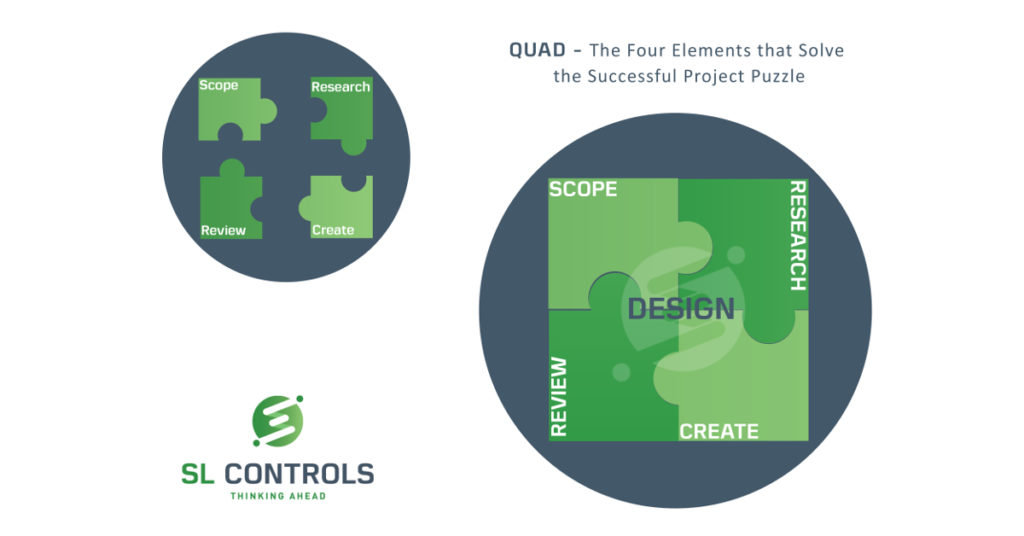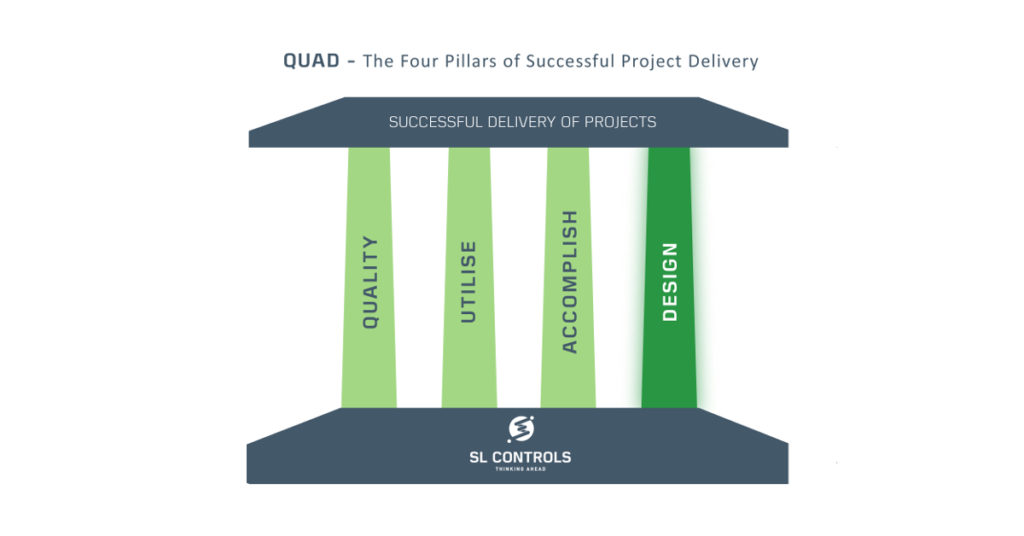Successful projects don’t happen by accident. Instead, they need carefully developed and well-established structures. At SL Controls, we use the QUAD approach.
The QUAD approach for the successful delivery of projects is built on four pillars – Quality, Utilise, Accomplish, and Design. We are going to focus on the Design pillar in this blog.

The Design Pillar Explained
Robust design is a prerequisite to a successful project. It involves delivering functionality and features according to client expectations. It also involves engineering out problems in the most timely and cost-effective way possible and delivering the project within agreed timescales.
Crucially, design does not take place at a fixed point in the project. Instead, it is continuously part of the process with ongoing reviews and updates. It involves four main elements:
- Scope
- Research
- Create
- Review

A very structured and methodical approach to design is essential. At SL Controls, for example, we have a dedicated design team/group in the business. This team includes our most experienced people in solution design and architecture to ensure the project moves forward successfully.
What about the four main elements?
Scope
Without getting an accurate and agreed scope, the design team, developers, and others will have no firm or clear idea what the project is about. They can guess and make best estimates, but, without a scope, there will always be differences between what the client wants to achieve and what those delivering the project think the client wants to achieve.
So, agreeing the scope is an essential starting point.
The scope will then lead to a URS (User Requirements Specification) that must be agreed by all parties, so everyone understands what is involved.
Given the scope is such an important element, a lot of time goes into its preparation. That said, it is also necessary to make provision for when projects change during development. This requires a process of updating and getting new agreement on the amended scope and, when necessary, the amended URS.
Research
The research element involves researching different aspects of the scope to identify the best solution for the client. At SL Controls, our most experienced people lead on this part of a project and they use a range of techniques to conduct the research.
This includes using the in-house knowledge of our own people as well as our own internal design standards. It also involves referring to industry standards and best practices, plus we often use experiences, results, and lessons from past projects.
Feasibility studies can be part of the process too, depending on the project, plus it is sometimes necessary to bring in subject matter experts. This is beneficial when you have some knowledge and experience of an aspect of the project but believe the overall solution could be enhanced with the in-depth knowledge of a subject-matter expert.
Create
With the scope and all the research elements in place, it is now possible to create the design. The first step is to create a functional design specification. Functional risk assessments take place at this stage too, and actions are put in place to minimise identified risks.
The project then gets broken down further into an SDS (System Design Spec) which is essentially a blueprint of the project that developers can then work from.
Creating these documents is not enough, however, as it is easy to introduce problems at this stage. It is, therefore, beneficial to have a review system in place. At SL Controls, we use a peer review system where a peer in the design group reviews all documents.
In addition, system architects, managers, the quality department, and the client also review and approve the documents.
Review
Design is no good if it is static as this keeps problems in the project until the latter stages. In fact, without a robust and ongoing review system, you might not identify problems with the design until the install and commissioning stages of the project.
The problem with this is the financial and time costs involved in resolving a problem exponentially increases the longer the problem remains in the system.
Continuous review of the design and other aspects of the project helps prevent this. For example, when developers writing the code uncover issues, the design immediately goes back to the design team to resolve before moving on.
Benefits of the Design Pillar
Reducing the occurrence of errors in the latter stages of the project has several benefits:
- Lowers project costs
- Minimises delays
- Avoids reputational issues, including reputational risks the client faces by manufacturing sub-standard products as a result of errors in the project
In addition, by implementing all elements of the Design pillar in the QUAD approach, you will get a more robust design that delivers on client expectations.






Comments are closed.